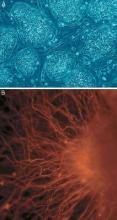In a first for human embryonic stem cell therapy, use of the pluripotent cells to treat macular dystrophy and macular degeneration significantly improved visual acuity without adverse proliferation, rejection, or serious systemic safety issues for a median of nearly 2 years after transplantation.
“The results of this study provide the first evidence of the medium-term to long-term safety, graft survival, and possible biological activity of pluripotent stem cell progeny in individuals with any disease,” wrote Dr. Steven D. Schwartz, from the Jules Stein Eye Institute Retina Division, Los Angeles, and colleagues.
“Our results suggest that hESC-derived cells could provide a potentially safe new source of cells for the treatment of a variety of unmet medical conditions caused by tissue loss or dysfunction,” the authors noted.
In two prospective phase I/II studies using human embryonic stem cell therapy (hESC)-derived retinal pigment epithelium – one involving nine patients with Stargardt’s macular dystrophy, and the second in nine patients with atrophic age-related macular degeneration – 13 (72%) patients showed an increase in subretinal pigmentation after transplantation of the cells into the subretinal space.
Six months after the transplant, patients with age-related macular degeneration showed improvements in visual acuity by at least 15 letters in four eyes (which the authors described as a clinically significant measure of improvement) and 11-14 letters in two eyes. Visual acuity remained stable (equal to or less than 10 letters) in three eyes, according to a paper published online in the Oct. 15 issue of the Lancet.
In the patients with Stargardt’s macular dystrophy, visual acuity data from eight patients at the 6-month follow up showed improvement by at least 15 letters in three eyes, stable in four eyes, and decreased by 11 letters in one eye (Lancet 2014, Oct. 15 [http://dx.doi.org/10.1016/S0140-6736(14)61376-3]).
Four treated eyes developed visually significant progression of cataracts. One patient with Stargardt’s macular dystrophy developed severe vitreous cavity inflammation consistent with acute postoperative endophthalmitis in one eye within 4 days of surgery, while another eye developed vitreous inflammation. All of those adverse events are associated with vitreoretinal surgery and immunosuppression.
“Additionally, there were no occurrences of adverse proliferation, growth of transplanted tissue at the injection site that was suggestive of a teratoma, ectopic tissue (nonretinal pigment epithelium), or other significant ocular adverse safety issues related to the hESC-retinal pigment epithelium cells in any patient during the observation period,” the researchers wrote.
In the eyes with age-related macular degeneration that did not develop cataracts in the first 6 months of follow-up, researchers noted a median improvement in visual acuity of 16 letters at 6 months, and 14 letters at 12 months, compared with no improvements at 6 months or 12 months in the untreated fellow eyes.
The treatment was delivered to sites with native but compromised retinal pigment epithelium and overlying photoreceptors, with the goal of improving the chances of transplant integration and photoreceptor cell rescue.
Patients from each study were divided into three dose cohorts receiving 50,000, 100,000, and 150,000 cells, and all received immunosuppressive therapy with tacrolimus and mycophenolate mofetil, from 1 week before the surgical procedure until 12 weeks after it.
The work is a “major accomplishment” that has already facilitated other trials of human embryonic stem cell therapy, noted Dr. Anthony Atala of the Wake Forest Institute for Regenerative Medicine, Winston-Salem, N.C., in an accompanying editorial (Lancet 2014, Oct. 15 [http://dx.doi.org/10.1016/S0140-6736(14)61820-1]).
“Now, we have follow-up that extends to longer than 3 years in patients treated with hESC-derived stem cells, showing both safety and apparent efficacy,” he wrote.
Advanced Cell Technology funded the study. Dr. Schwartz has received research support and consulting fees from Alcon, Allergan, Avalanche, Bausch and Lomb, Genentech, and Regeneron. Six of the study authors were employees of Advanced Cell Technology. The editorial author declared no conflicts of interest.


